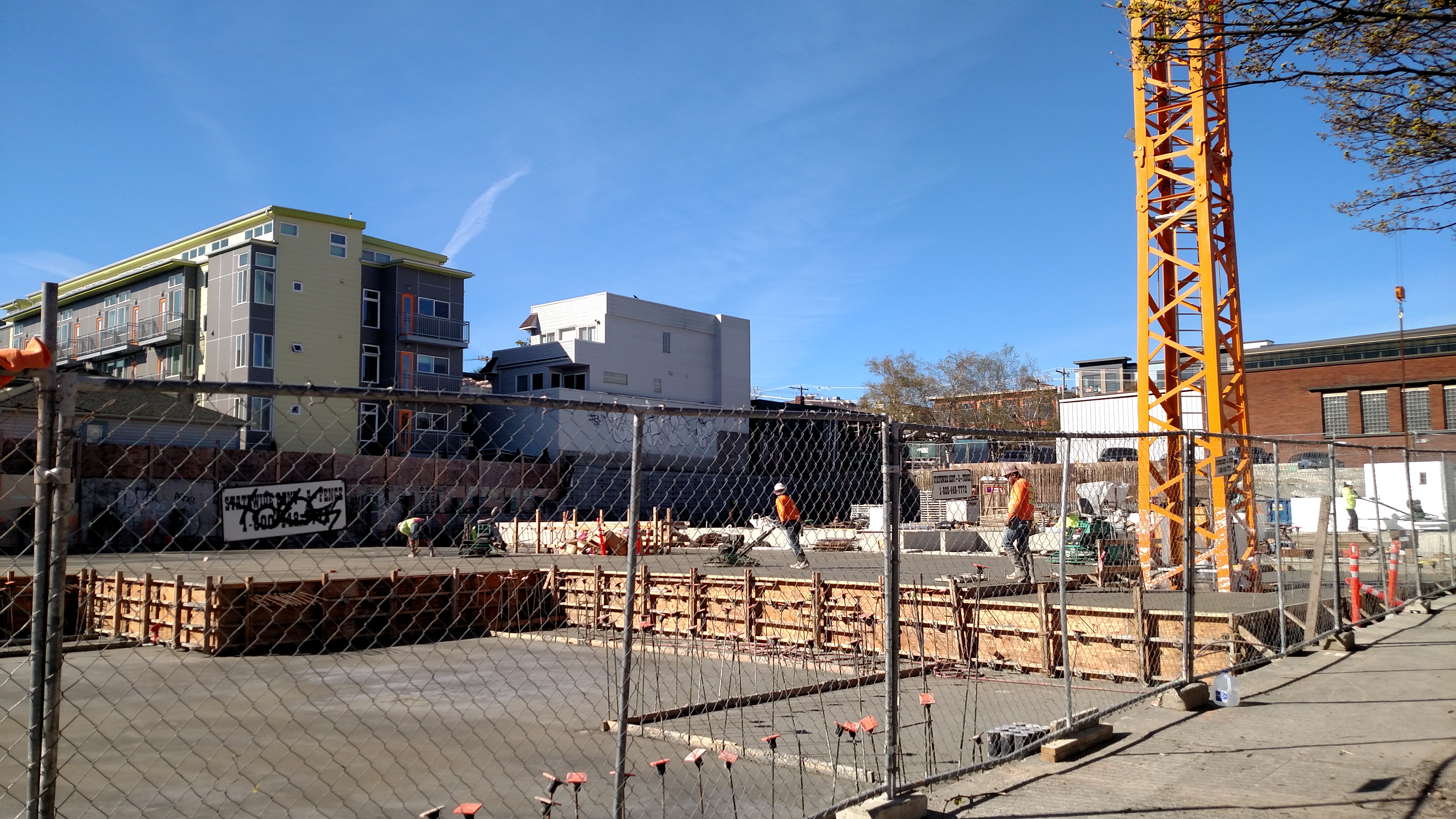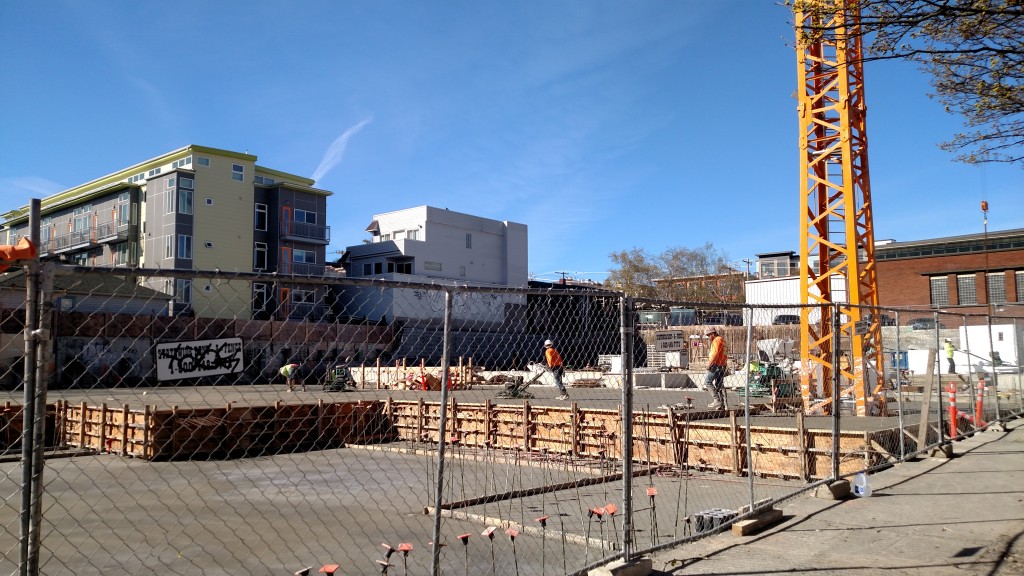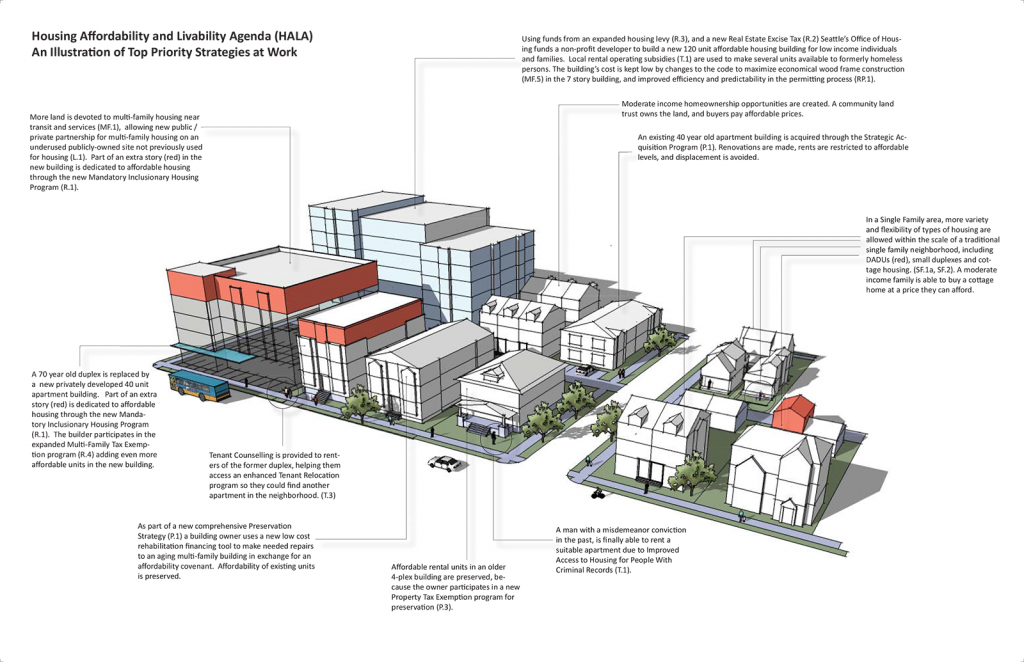
With several HALA provisions still up in the air and rents still spiking, the battle for affordable housing is urgent as ever. Mandatory inclusionary zoning (MIZ) is expected to go online next year and together with the commercial linkage fee create 6,000 rent-restricted units in a decade’s time. Some lobbyists like Roger Valdez are still fighting to stop MIZ and he and some national pundits are skeptical MIZ will do much good. The skeptics’ argument hinges on the assertion MIZ would hinder housing production. The empirical evidence does not support that assertion; robust market-rate housing production and MIZ are not mutually exclusive.
The Urbanist did a deep-diving analysis last year in a piece called Why Urbanists Must Support Linkage Fees and Inclusionary Zoning: A Scalable Policy For Affordable Neighborhoods. Owen Pickford wrote:
There are five academic studies examining empirical evidence about the impact of inclusionary zoning on market rate housing production. Out of these five studies, only one found a relevant negative impact. That study, published by the libertarian think tank Reason, failed to acknowledge larger market forces, drastically oversimplified its models, and could be reasonably accused of intentionally misleading its audience. You can read a criticism of the study here.
The other four studies found inconsequential or no impact on market-rate housing production.
Meanwhile, one urbanist blogger we hold in high esteem, Daniel Kay Hertz (with City Observatory), has been vocal that inclusionary zoning is misguided. In an article titled Inclusionary Zoning Has A Scale Problem, Hertz wrote, “The point is not that inclusionary zoning is the enemy of affordable housing. It’s that it’s not that great a friend.” Recently Hertz extended an olive branch by praising a Shelterforce article by inclusionary zoning expert Rick Jacobus. The part Hertz liked was how strongly Jacobus emphasized the need to build more housing. Perhaps that was surprising, but, like Jacobus, we at The Urbanist support both MIZ and building tons of market-rate housing in Seattle.

Jacobus criticized relying too heavily on market forces such as filtering to provide very low-income housing but acknowledged we have good reason to believe it can help people in the moderate-income range:
Now, filtering is not quite the panacea that some wish it were because once rents on older housing units fall below the operating costs, it is cheaper for property owners to abandon their buildings than rent them out. This creates a functional rent floor below which rents won’t fall no matter how much we build; but in high-cost regions the bottom of the housing market (the lowest rents typically available) is far above this floor. And to reach that floor we would need to build at such an enormous scale that it is hardly worth discussing. So building more won’t end homelessness or eliminate the need for affordable housing subsidies for very low-income households, but for everyone else struggling to pay rising rents, there is solid evidence that building even high-end housing will bring rents and housing prices down. Even if we can’t hope to build enough, some building is better than no building.
So, we have agreement that market-rate housing is a crucial part of the puzzle, but let’s not oversell what the market can do in a very high-demand city. We are talking about slowing rent increases, not seeing actual rent decreases, but the language overzealous advocates use can give the impressions of dropping rents. In January Hertz wrote:
[R]ents in Seattle, Denver, and Washington, DC appear to be easing significantly. In what a local business paper describes as an “alarming deterioration”—though renters probably have different words for it—the average Seattle rent fell by $59 in the last quarter of 2015, following a long period of rapid increases. Not coincidentally, vacancies also increased by a full percentage point. The Puget Sound Business Journal reports that landlords have reason to worry that things aren’t going to get any “better” for them: another 21,600 units of housing under construction should hold down rent growth into the coming year, too.
Hertz misrepresented the report which in fact showed rents fell only in the highest-end sub-markets, while continuing to climb overall. The prediction for the coming year also proved wrong in a few short months, as recent reports showed rents still steadily climbing. Nonetheless, City Observatory‘s other writer Joe Cortright was still citing Hertz’s original misinterpretation of the Seattle housing market data this month despite it being wrong at the time and even more wrong now. While building tons of supply is great, it seems the short term result we should expect is lower rent hikes, not lower rents.
We shouldn’t be leading tenants to believe their rents will go down from market-rate housing when evidence only shows their rents might not increase as rapidly. This is different than real rent decreases. In the long-term, filtering should work some magic, allowing market-rate units to serve more of the moderate-income market. But, as Jacobus pointed out, units will never filter all the way down into very low-income markets. It is true, though, that robust housing supply can lower the amount of subsidy the government needs to provide but no one really knows what the lowest income levels are that can be effectively served by the private market in large cities.
While praising Jacobus for a nuanced argument, Hertz couldn’t help but stereotype inclusionary zoning advocates and exhibiting little nuance on the subject:
And at the local level, the focus on inclusionary zoning and impact fees has both fed on and promoted the fantasy that all we need to do to solve the affordable housing crisis is squeeze developers hard enough. In reality, only a broadly-funded commitment to funding housing assistance has any shot at reaching the required scale. And even that won’t have the needed effect unless we build enough market-rate housing to get prices down and reduce the per-unit cost of subsidies.
Seattle’s MIZ program isn’t about squeezing developers since its paired with beneficial upzones. That helps explains why many developers signed on to the program as part of the Grand Bargain. We should feed on neither anti-developer fantasies nor free-market fantasies as we seek a political path to housing solutions both immediate and long-term. Hertz’s preferred solutions — such as reforming the tax code — require massive changes at the federal level. That’s just not something we’ve seen in a long time. We’d love to see a more progressive, affordable-housing-friendly tax code, but we must forge ahead with local level solutions, too. Plus, he is still working off the assumption that MIZ is going to hamper housing production and again that is a supposition not borne out by a closer look at the evidence.

To focus on our local example, I don’t think the HALA committee or housing advocates are saying MIZ will solve the affordable housing crisis. Seattle’s existing optional inclusionary zoning program has only averaged about 50 units per year since 2001 when it was implemented. Making the program mandatory in the midst of Seattle’s building boom should boost the rate of production, but admittedly it’s a modest solution to a huge problem that will require multiple solutions. On the other hand, MIZ has the potential to create a coalition that pursues increased densities in order to produce more affordable housing. It also helps ensure income integration, a huge sociological benefit at a time when cities are increasingly segregated by income level. The question is, are the negative effects of MIZ certain? And if so, are they significant enough to pass up these sociological benefits, the political benefits, and the ability to creating hundreds of affordable units per year without raising new city revenue?
Hertz linked inclusionary zoning to anti-developer extremism, but I don’t think that’s how Seattle’s existing (non-mandatory) inclusionary zoning program has worked, and it’s not how the planned MIZ program will work. Heck, even The Seattle Times, normally a very pro-business paper, endorsed the approach. Seattle’s MIZ program is not designed to fleece developers, just to get them to make a modest investment in affordable housing. And crucially, some of MIZ’s cost will be born by landowners not by developers or by market-rate renters. By lowering slightly how much developers are willing to bid on land, the program will capturing some of spiking land value that landowners are exploiting to huge windfalls. The requirement is low: only 5% to 7% of new units need to be affordable or developers can pay an in-lieu fee. In exchange, developers benefit from a density bonus. Developers aren’t being asked to do the impossible and the overarching guiding principle of HALA is still: we need a big building boom.
If the next 100,000 multi-family units in Seattle are built under MIZ, Seattle will benefit from 5,000 to 7,000 affordable units with rents restricted below 60% of AMI for 50 years in the most amenity-rich neighborhoods without costing taxpayer dollars. We agree with Hertz. Cities, states and the federal government need to pursue more ambitious housing policies. Many of us strongly support his biggest proposal, a bigger capital gains tax on real estate. But that doesn’t preclude MIZ. Mandatory inclusionary zoning may not be a gamechanger given the scope of the housing shortage, but it’s nothing to scoff at either.
Doug Trumm is publisher of The Urbanist. An Urbanist writer since 2015, he dreams of pedestrian streets, bus lanes, and a mass-timber building spree to end our housing crisis. He graduated from the Evans School of Public Policy and Governance at the University of Washington in 2019. He lives in Seattle's Fremont neighborhood and loves to explore the city by foot and by bike.

